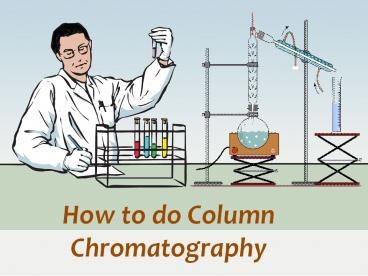Column Chromatography - PowerPoint PPT Presentation
Title:
Column Chromatography
Description:
Column Chromatography: A Step-by-Step Guide on How to do it – PowerPoint PPT presentation
Number of Views:402
Title: Column Chromatography
1
How to do Column Chromatography
2
Column Chromatography
3
Here are the steps involved in Column
Chromatography
4
(No Transcript)
5
1) Preparation / Packing of an adsorbent column
6
2) Solvent system / Mobile phase
Column chromatography uses a single solvent. The
commonly used ones are petroleum ether, benzene,
carbon tetrachloride, ethyl acetate, acetone,
cyclohexane, ether, chloroform, etc.
7
The role of the solvent in column chromatography
is
8
3) Application of samples
The study sample can be applied to the top of the
prepared column in various ways
- Remove most of the mobile phase from above the
column using a substrate and drain the remaining
solvent into the column bed. Apply the sample
carefully with a pipette and allow it to run in
the column. To wash the final traces of the
sample into the column bed, apply a small volume
of the mobile phase. Carefully add the mobile
phase to the column to the height of 2-5 cm and
maintain it by connecting the column to a
suitable reservoir of mobile phase.
9
- Add sucrose to a concentration of 1 to increase
the density of the sample when the solution is
layered into the liquid above the column bed it
will automatically sink to the surface of the
column. - Use capillary tubing or roller pumps to pass the
sample directly to the column surface.
10
4) Sample elution
After sample application, the next step is to
remove the material from the column using an
appropriate solvent. This can be carried out in
following ways
11
(No Transcript)
12
5) Collection and analysis of fraction
Collect the fractions from the column into a
series of test tubes, either manually or with a
fraction collector. Analyze each fraction for the
presence of the compound. Colored compounds can
be detected by visual observation, but colorless
compounds are detected by spectrophotometer or
colorimetry or UV adsorption method.
13
Contact Us
- E-mail project_at_cognibrain.com
- Phone 044-49595223
- URL https//www.cognibrain.com/
















![Lecture note : Gas chromatography [1] ????????? PowerPoint PPT Presentation](https://s3.amazonaws.com/images.powershow.com/6692254.th0.jpg?_=20150604093)














